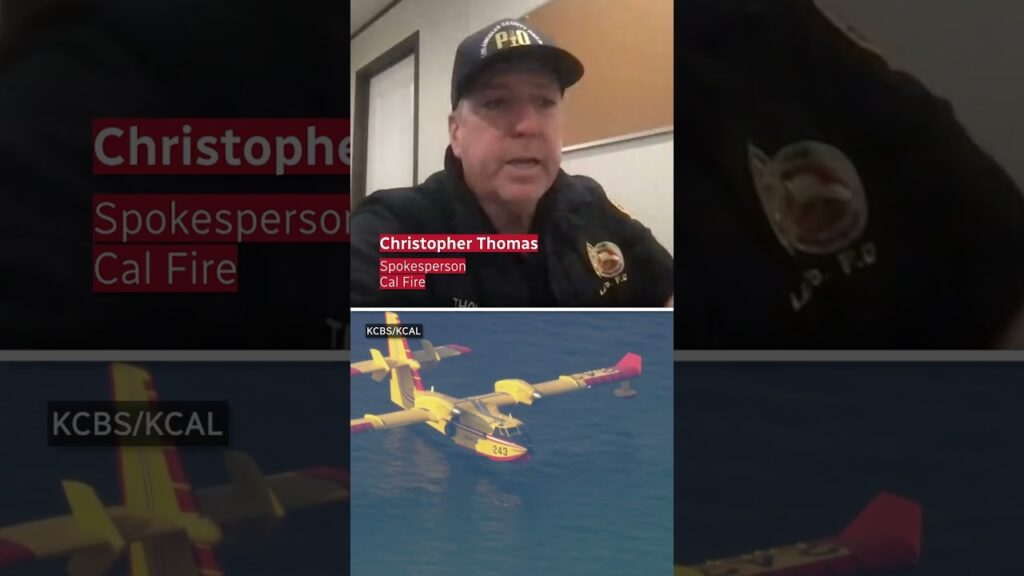Navigating the Hot Zone: Understanding Drone Risks in Wildfire Operations
The roar of a Super Scooper, skimming low over a lake’s surface to gulp down thousands of gallons of water, is a sound that brings a sliver of hope during a wildfire. These specialized aircraft are vital tools in battling blazes that threaten communities and ecosystems. But in the increasingly crowded skies above these disaster zones, a new and concerning hazard has emerged: drones. The recent incident involving a drone colliding with a Super Scooper fighting the Palisades Fire in Los Angeles serves as a stark reminder of the potential consequences. This page will delve into the key takeaways from recent reports, highlighting the dangers and emphasizing the critical need for responsible drone operation. Understanding these risks is paramount to ensuring the safety of aerial firefighting efforts and preventing future incidents. Let’s examine the insights gleaned from recent video coverage to understand the gravity of this situation.
Key Takeaways: Drone Encounters with Wildfire Operations
Here’s what we’ve learned from recent video reports regarding drones and Super Scoopers in wildfire zones:
- Super Scoopers are Critical Assets: Videos 1, 2, and 4 highlight the deployment of Canadian CL-415 "Super Scoopers" to assist in fighting the significant wildfires in the Los Angeles area. These aircraft are specifically designed for rapid water collection and deployment, playing a crucial role in containing and extinguishing fires. Their presence underscores the scale and severity of these events.
- A Mid-Air Collision Occurred: Video 3 explicitly reports on a drone colliding with a Super Scooper involved in fighting the Palisades Fire. This incident resulted in the aircraft being grounded due to damage, directly impacting firefighting capabilities. This is the central concern and underscores the "Drone Danger ✈️" aspect of this issue.
- Significant Disruption to Firefighting Efforts: As detailed in videos 3 and 5, the collision forced the Super Scooper to land and be subsequently grounded. This takes a valuable asset out of commission during a critical time, potentially delaying containment efforts and increasing the risk to lives and property. The grounding also necessitates inspections and repairs, further extending the downtime.
- Federal Investigation Underway: Video 5 mentions the involvement of the FAA and FBI in investigating the drone collision. Video 6 shows images released by the FBI of the damaged Super Scooper and drone fragments. This highlights the seriousness of the incident and the potential legal ramifications for the drone operator. Such investigations are crucial for understanding the circumstances and preventing future occurrences.
- Public Awareness and Education are Crucial: The commentary sections of these videos (referenced by comment counts) likely contain a mix of reactions, including shock, anger, and calls for greater drone regulation and operator responsibility. This underscores the need for widespread education about the risks of operating drones in restricted airspace, particularly near active wildfire zones.
Lessons Learned from the Fire Zone: Preventing Future Drone-Aircraft Conflicts
The incident involving the Super Scooper isn’t just an isolated event; it’s a stark lesson in airspace safety and the potential consequences of irresponsible drone operation. As professional drone pilots, we understand the immense value drones bring to various fields. However, operating in shared airspace, especially during emergency situations like wildfires, demands the utmost caution and adherence to regulations.
The operational environment around wildfires is dynamic and inherently dangerous. Super Scoopers, for instance, operate at low altitudes, often making repeated passes over water sources and the fire itself. Their flight paths are dictated by the immediate needs of the firefighting effort, leaving little room for error or unexpected obstacles. A small drone, seemingly insignificant, can cause catastrophic damage to a much larger aircraft, as demonstrated in this incident.
Here are key takeaways for all drone operators:
- Know Your Airspace – Always: Before every flight, consult resources like the FAA’s B4UFLY app and LAANC (Low Altitude Authorization and Notification Capability) to understand airspace restrictions. Temporary Flight Restrictions (TFRs) are frequently implemented over wildfire areas, prohibiting drone operations. Ignorance is not an excuse, and the consequences can be severe, both legally and in terms of potential harm.
- Maintain Visual Line of Sight (VLOS): Operating beyond visual line of sight, especially in complex environments like wildfire zones, significantly increases the risk of collision. Maintaining VLOS allows for immediate reaction to unexpected air traffic.
- Utilize Available Technology: Many modern drones are equipped with features like geofencing, which can help prevent flight into restricted areas. Ensure these features are enabled and configured correctly.
- If You See Aerial Firefighting Aircraft, Land Immediately: There is no ambiguity here. If you spot a helicopter or fixed-wing aircraft involved in firefighting operations, bring your drone down safely and immediately.
- Public Education is Paramount: The drone community needs to actively promote responsible flying practices. Share information about the dangers of operating near wildfires and the importance of respecting airspace restrictions.
The Takeaway: Shared Skies, Shared Responsibility
The videos highlighted on this page serve as a critical reminder: the airspace above wildfires is a shared and often congested environment. The safety of manned aircraft and the effectiveness of their vital mission depend on the responsible actions of all airspace users, including drone pilots. This incident with the Super Scooper is a sobering example of how a small, errant drone can have significant and dangerous consequences.
Scroll down to view the video highlights and witness firsthand the discussions surrounding this critical issue. Let’s work together to ensure the skies remain safe for those bravely fighting wildfires.






